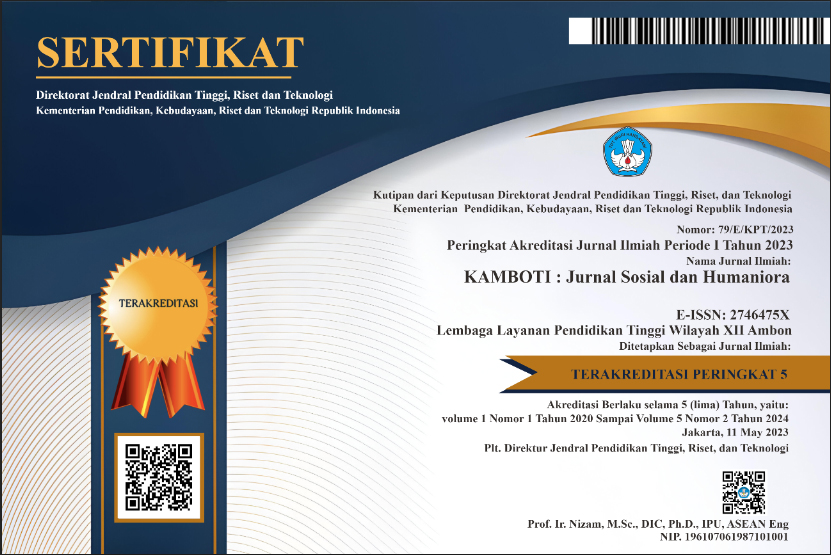Unraveling the Motivational Threads of Content Creators Embracing Mud Bath Content on TikTok
DOI:
https://doi.org/10.51135/kambotivol3issue2page18-27Keywords:
Begging Online, Content Creator, Motivatioan, Live Mud Bath, TikTokAbstract
References
Anderson, D. R., Sweeney, D. J., Williams, T. A., Camm, J. D., & Cochran, J. J. (2016). Statistics for business & economics. Cengage Learning.
Arifin, M. S., Fauzi, M., & Umam, H. (2023). Fenomena Mandi Lumpur Live Tiktok dalam Perspektif Islam. Al-Ibrah: Jurnal Pendidikan Dan Keilmuan Islam, 8(1).
Beldad, A. D., & Koehorst, R. (2015). It’s not about the risks, I’m just used to doing it: Disclosure of personal information on facebook among adolescent dutch users. Social Computing and Social Media: 7th International Conference, SCSM 2015, Held as Part of HCI International 2015, Los Angeles, CA, USA, August 2–7, 2015, Proceedings 7, 185–195. Springer.
Brandtzæg, P. B., & Heim, J. (2009). Why people use social networking sites. Online Communities and Social Computing: Third International Conference, OCSC 2009, Held as Part of HCI International 2009, San Diego, CA, USA, July 19-24, 2009. Proceedings 3, 143–152. Springer.
Chen, C.-C., & Lin, Y.-C. (2018). What drives live-stream usage intention? The perspectives of flow, entertainment, social interaction, and endorsement. Telematics and Informatics, 35(1), 293–303.
Cheung, C. M. K., Chiu, P.-Y., & Lee, M. K. O. (2011). Online social networks: Why do students use facebook? Computers in Human Behavior, 27(4), 1337–1343.
Cortinhas, C., & Black, K. (2012). Statistics for business and economics. John Wiley & Sons.
Fauzi, M., Arifin, M. S., & Umam, H. (2022). Fenomena Mandi Lumpur Live Tiktok Dalam Perspektif Islam. Al-Ibrah: Jurnal Pendidikan Dan Keilmuan Islam, 7(2), 110–129.
Greenwood, D. N. (2013). Fame, Facebook, and Twitter: How attitudes about fame predict frequency and nature of social media use. Psychology of Popular Media Culture, 2(4), 222.
Hollenbaugh, E. E., & Ferris, A. L. (2014). Facebook self-disclosure: Examining the role of traits, social cohesion, and motives. Computers in Human Behavior, 30, 50–58.
Jannah, W., & Fasadena, N. S. (2023). Fenomena Mandi Lumpur Live di Tiktok Menurut Teori Dramaturgi Erving Goffman. JISAB: The Journal of Islamic Communication and Broadcasting, 2(2), 152–164.
Joinson, A. (2008). ‘Looking at’, ‘looking up’ or ‘keep-ing up with’ people? Motives and uses of Facebook. CHI 2008 Proceedings· Online Social Networks. Retrieved from https://digitalwellbeing.org/downloads/Joinson_Facebook.pdf
Kim, D., Kim, J.-H., & Nam, Y. (2014). How does industry use social networking sites? An analysis of corporate dialogic uses of Facebook, Twitter, YouTube, and LinkedIn by industry type. Quality & Quantity, 48, 2605–2614.
Levy, P. S., & Lemeshow, S. (2013). Sampling of populations: methods and applications. John Wiley & Sons.
Lin, K.-Y., & Lu, H.-P. (2011). Why people use social networking sites: An empirical study integrating network externalities and motivation theory. Computers in Human Behavior, 27(3), 1152–1161.
Malhotra, N. K. (2012). Basic marketing research: Integration of social media.
PKM-RSH UGM. (2023). Menjual Kesedihan Demi Cuan: Fenomena Ngemis dan Nyawer Online pada TikTok Live. Retrieved from https://www.goodnewsfromindonesia.id/2023/10/03/menjual-kesedihan-demi-cuan-fenomena-ngemis-dan-nyawer-online-pada-tiktok-live
Ryan, R. M., & Deci, E. L. (2000). Self-determination theory and the facilitation of intrinsic motivation, social development, and well-being. American Psychologist, 55(1), 68.
Sangadji, S. (2023). Management Research Methods. PROCURATIO: Jurnal Manajemen & Bisnis, 2(1), 43–44. https://doi.org/10.62394/projmb.v2i1.58
Schmidt, W. C. (1997). World-wide web survey research made easy with www survey assistant. Behavior Research Methods, Instruments & Computers.
Sidel, J. L., Bleibaum, R. N., & Tao, K. W. C. (2018). Quantitative descriptive analysis. Descriptive Analysis in Sensory Evaluation, 287–318.
Silaban, P. H., Silalahi, A. D. K., Chen, W.-K., Sangadji, S. S., Eunike, I. J., & Panggabean, F. (2023). Uncover Configurational Paths of Streamers’ Characteristics Predicting High vs. Low Consumers’ Watching Intention to TikTok Live Streaming. 2023 International Conference on Information Management and Technology (ICIMTech), 113–118. IEEE.
Stone, H. (1992). Quantitative Descriptive Analysis. Manual on Descriptive Analysis Testing for Sensory Evaluation, 15.
Supriatin, F., Marliana, I., S. Sangadji, S., Afkar, Paerah, A., & Dharta, F. (2022). Metodologi Penelitian. Makassar: Cendikia Publisher. https://doi.org/10.31219/osf.io/ywemh
Tosun, L. P. (2012). Motives for Facebook use and expressing “true self” on the Internet. Computers in Human Behavior, 28(4), 1510–1517.
Vauziyah, D. T. (2023). Analisis ju’alah terhadap perolehan gift live streaming pada aplikasi TikTok: studi kasus tren mandi lumpur di aplikasi TikTok. Universitas Islam Negeri Sunan Ampel Surabaya. Retrieved from http://digilib.uinsa.ac.id/66192/
We Are Social and Hootsuite. (2023). Global Overview Report — DataReportal – Global Digital Insights. Retrieved April 13, 2023, from https://datareportal.com/reports/digital-2023-global-overview-report
Zhao, Q., Chen, C.-D., Cheng, H.-W., & Wang, J.-L. (2018). Determinants of live streamers’ continuance broadcasting intentions on Twitch: A self-determination theory perspective. Telematics and Informatics, 35(2), 406–420.
Downloads
Published
Issue
Section
License
Copyright (c) 2023 KAMBOTI: Jurnal Sosial dan Humaniora

This work is licensed under a Creative Commons Attribution-ShareAlike 4.0 International License.



